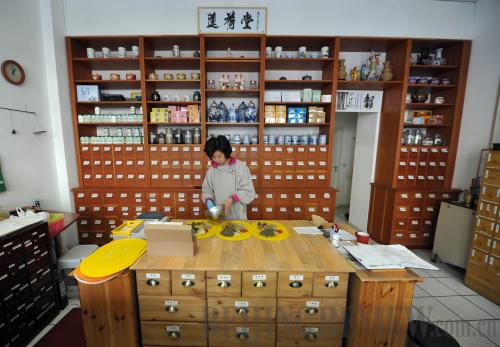|
 |
|
GOING OVERSEAS: A doctor prepares TCMs for her patient at Lianhetang, a TCM store in Berlin, Germany (MA NING) |
For centuries, traditional Chinese medicine (TCM) has been a national treasure. The TCM industry, however, has yet to take a leading role among the country's medical businesses. Worse still, TCM lags far behind Western medicine in both industry and daily use.
China's pharmaceutical industry had an output value of 1.256 trillion yuan ($193.2 billion) in 2010, said the National Development and Reform Commission (NDRC). Of this total, TCM accounted only for 317 billion yuan ($48.8 billion).
The cause
In the early years of the 20th century, Western medicine entered China to challenge TCM's foothold. According to data from the Ministry of Health and the State Administration of Traditional Chinese Medicine, the Western medicine industry outsized the TCM business in terms of output value in the 1980s.
In a recent report, the Shenzhen-based industry research company CIConsulting said TCM producers face three major stumbling blocks on the path of development.
First, a lack of investment in research and development (R&D), and outdated technology and product innovation have set the industry back. In 2000, the United States needed to invest $802 million to develop a new medicine for over a decade, with R&D costs accounting for at least 15 percent of the eventual sales revenue of the product. But in China, the ratio is less than 5 percent, and for many Chinese enterprises and research institutions, five or six years is all the time they can commit to this kind of endeavor.
Western medicines are continuously updated. New products replace outdated ones on a regular basis. TCMs' service lives are infinite—some of them are never replaced. Most renowned and commonly used TCMs have been used for hundreds or even thousands of years, witnessing little progress in manufacturing techniques. The Liuwei Dihuang pill, for example, has gone through several name and packaging changes, but its production technique remains the same as 1,800 years ago. The pill, created by Zhang Zhongjing, a well-known doctor in the Eastern Han Dynasty (25-220), is usually used to treat chronic nephritis, hypertension and diabetes.
Second, the TCM industry is fragmented, with many small manufacturers engaged in the production. Data from the NDRC showed China had more than 2,300 patent drug producers in 2010, manufacturing more than 4,000 kinds of products. But a large proportion of them is modified versions of the originals.
Third, the industry lacks an effective and widely recognized standard. Nowadays consumers measure curative effect according to the standard set by Western medicine.
"Lacking a standard is the biggest bottleneck choking the sector's development," said Liu Jianxun, a researcher with the China Academy of Chinese Medical Sciences (CACMS). "It also makes it very difficult for TCM to break into international markets."
Patients are also partial to Western medicine, since it takes effect much quicker than TCM, said Liu.
Changes under way
The good news is the Institute of Medicinal Plant Development under the Chinese Academy of Medical Sciences is using modern methodology to explore the TCM bonanza and upgrade the centuries-old domestic industry.
Unlike their Western counterparts, Chinese researchers focus on the properties of TCMs. Few TCM manufacturers analyze their material structure and function mechanism of their molecules and cells. That has obviously impeded the development of the TCM industry and affected the spread of TCMs all over the world.
| 